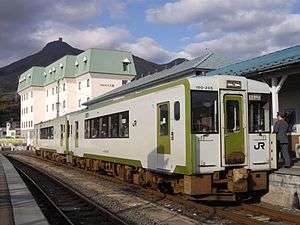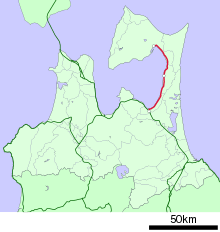Ōminato Line
The Ōminato Line (大湊線, Ōminato-sen) is a railway route operated by East Japan Railway Company (JR East). It connects Noheji Station and Ōminato Station on the Shimokita Peninsula in eastern Aomori Prefecture.[1]
| Ōminato Line | ||||||||||||||||||||||||||||||||||||||||||||||||||||||||||||||||||||||||||||||||||||||||
|---|---|---|---|---|---|---|---|---|---|---|---|---|---|---|---|---|---|---|---|---|---|---|---|---|---|---|---|---|---|---|---|---|---|---|---|---|---|---|---|---|---|---|---|---|---|---|---|---|---|---|---|---|---|---|---|---|---|---|---|---|---|---|---|---|---|---|---|---|---|---|---|---|---|---|---|---|---|---|---|---|---|---|---|---|---|---|---|---|
 A KiHa 100 series DMU at Ominato Station on a Shimokita rapid service in October 2009 | ||||||||||||||||||||||||||||||||||||||||||||||||||||||||||||||||||||||||||||||||||||||||
| Overview | ||||||||||||||||||||||||||||||||||||||||||||||||||||||||||||||||||||||||||||||||||||||||
| Native name | 大湊線 | |||||||||||||||||||||||||||||||||||||||||||||||||||||||||||||||||||||||||||||||||||||||
| Type | Heavy rail | |||||||||||||||||||||||||||||||||||||||||||||||||||||||||||||||||||||||||||||||||||||||
| Termini | Noheji Ōminato | |||||||||||||||||||||||||||||||||||||||||||||||||||||||||||||||||||||||||||||||||||||||
| Stations | 11 | |||||||||||||||||||||||||||||||||||||||||||||||||||||||||||||||||||||||||||||||||||||||
| Operation | ||||||||||||||||||||||||||||||||||||||||||||||||||||||||||||||||||||||||||||||||||||||||
| Opened | 1921 | |||||||||||||||||||||||||||||||||||||||||||||||||||||||||||||||||||||||||||||||||||||||
| Owner | East Japan Railway Company | |||||||||||||||||||||||||||||||||||||||||||||||||||||||||||||||||||||||||||||||||||||||
| Rolling stock | KiHa 100 series | |||||||||||||||||||||||||||||||||||||||||||||||||||||||||||||||||||||||||||||||||||||||
| Technical | ||||||||||||||||||||||||||||||||||||||||||||||||||||||||||||||||||||||||||||||||||||||||
| Line length | 58.4 km (36.3 mi) | |||||||||||||||||||||||||||||||||||||||||||||||||||||||||||||||||||||||||||||||||||||||
| Track gauge | 3 ft 6 in (1,067 mm) | |||||||||||||||||||||||||||||||||||||||||||||||||||||||||||||||||||||||||||||||||||||||
| Electrification | none | |||||||||||||||||||||||||||||||||||||||||||||||||||||||||||||||||||||||||||||||||||||||
| ||||||||||||||||||||||||||||||||||||||||||||||||||||||||||||||||||||||||||||||||||||||||

Station list
| Station | Japanese | Distance (km) | Rapid Shimokita |
Transfers | Location | ||
|---|---|---|---|---|---|---|---|
| Between stations |
Total | ||||||
| Noheji | 野辺地 | - | 0.0 | ● | Aoimori Railway Line | Noheji | Aomori |
| Kita-Noheji | 北野辺地 | 2.8 | 2.8 | | | |||
| Arito | 有戸 | 6.3 | 9.6 | | | |||
| Fukkoshi | 吹越 | 13.4 | 23.0 | | | |||
| Mutsu-Yokohama | 陸奥横浜 | 7.1 | 30.1 | ● | |||
| Arihata | 有畑 | 5.9 | 36.0 | | | Yokohama | ||
| Chikagawa | 近川 | 6.7 | 42.7 | ▲ | Mutsu | ||
| Kanayasawa | 金谷沢 | 5.0 | 47.7 | | | |||
| Akagawa | 赤川 | 5.5 | 53.2 | | | |||
| Shimokita | 下北 | 2.3 | 55.4 | ● | |||
| Ōminato | 大湊 | 2.9 | 58.4 | ● | |||
- ●: All rapid service trains stop, ○: Some rapid service trains stop
History
On March 20, 1921 the Ōminato Light Railway (大湊軽便線, Ōminato-keibensen) began operations between Noheji Station and Mutsu-Yokohama Station. The line was extended to its present terminus of Ōminato Station by September 25, 1921. In 1922 the line was nationalised, and renamed the Ōminato Line of the Japanese Government Railway (JGR, later JNR).
Express Natsudomari operations began from Aomori Station on a seasonal basis in 1968. The express was later downgraded to rapid service and renamed the Usori, and later the Shimokita. All freight operations ceased on February 1, 1984. With the dissolution and privatization of the JNR on April 1, 1984 the line came under the control of the East Japan Railway Company. On December 4, 1999 a new centralized traffic control (CTC) system became operational. In 2002, seasonal excursion train Kirakira Michinoku operations commenced and a limited number of Shimokita trains were extended to terminate at Hachinohe Station instead of Noheji. The Shimokita service operates a daily round trip to Aomori and 3 round trips to Hachinohe in conjunction with the Aoimori Railway.[2]
The Tōhoku Main Line, including Noheji was transferred from JR East to Aoimori Railway on December 4, 2010 following the extension of the Tohoku Shinkansen from Hachinohe to Shin-Aomori.[3] This resulted in the isolation of the Ōminato Line, a branch of the Tōhoku Main Line, from the rest of the JR East network with the exception of the Shimokita service from Aomori where it connects with the Ōu Main Line and Tsugaru Line.[2]
Former connecting lines
- Akagawa station - The Aomori Prefectural Government operated a 4 km 762mm (2'6") gauge line to Tanabu-Yanagicho between 1921 and 1941.
- Shimokita station - A 18 km line to Ōhata (大畑線) opened in 1939, and construction continued toward Ōma to service a proposed naval base to protect the Tsugaru Strait, and was well advanced when work was suspended in 1943 due to a shortage of materials. The Seikan Tunnel was originally proposed to utilise the roadbed of the uncompleted Ōma line (as well as that of the uncompleted Toi line near Hakodate) but in 1968 the route was changed to the alignment subsequently built. Freight services ceased on the Ōhata line in 1979, and operation of it was transferred to Shimokita Koutsu in 1985. The line closed in 2001.
References
This article incorporates material from the corresponding article in the Japanese Wikipedia.
- JTB Timetable December 2010 issue
- "Ominato Timetable". www.jreast.co.jp.
- "Rapid (Ominato - Noheji - Aomori)". www.jreast.co.jp.
- Tetsudo Hobidas: "JR東日本 東北本線八戸―青森間の廃止を届出 " (November 27, 2009). Retrieved February 7, 2018. (in Japanese)
.svg.png)